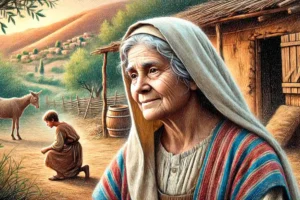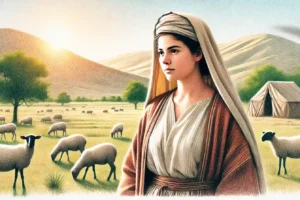
Esther: The Courageous Queen of Persia
Esther, the central figure in the Book of Esther, is a revered heroine in Jewish tradition. Known for her beauty, courage, and faith, she played a pivotal role in saving the Jewish people from genocide during the reign of King Xerxes (Ahasuerus) of Persia.
Short Quick Facts:
- Name Meaning: Esther’s name is derived from the Persian word for “star.”
- Biblical Role: Esther is the main character in the Book of Esther in the Old Testament.
- Background: She was an orphan raised by her cousin Mordecai.
- Royal Position: Esther became queen of Persia after winning a beauty contest.
- Concealed Identity: Initially, she kept her Jewish identity a secret as advised by Mordecai.
- Act of Bravery: Esther risked her life by approaching King Xerxes uninvited to reveal Haman’s plot against the Jews.
- Intercession: Her intercession led to the king’s decree allowing the Jews to defend themselves.
- Outcome: Haman was executed, and the Jewish people were saved.
- Legacy: The Jewish festival of Purim commemorates the events involving Esther.
Esther’s narrative is a profound example of bravery, faith, and divine intervention, with layers of historical and theological significance that continue to resonate within Jewish tradition and beyond.
Historical Context
Esther’s story is set during the Persian Empire, a vast and powerful realm ruled by King Xerxes (Ahasuerus). The Persian Empire, known for its grandeur and diverse population, including the Jewish exiles, provides the backdrop for the events in the Book of Esther. This period was marked by complex political dynamics and cultural interactions between the Jewish community and the Persian authorities.
Character and Faith
Esther, originally named Hadassah, was an orphan raised by her cousin Mordecai. Her Jewish identity was a defining part of her character, though initially concealed due to the precarious position of Jews in the empire. Esther’s beauty, grace, and humility won her favor with King Xerxes, making her queen. Despite her royal status, Esther remained deeply connected to her Jewish roots and obedient to Mordecai, reflecting her loyalty, humility, and faith.
Key Events and Actions
- Becoming Queen: Esther’s rise to queenship began with King Xerxes’ search for a new queen after the deposition of Queen Vashti. The king’s officials conducted a kingdom-wide search for the most beautiful young women, and Esther was among those selected. Her ascent to the throne was not merely due to her beauty but also to divine favor, setting the stage for her significant role in saving her people.
- Concealed Identity: At Mordecai’s advice, Esther kept her Jewish identity a secret. This act of concealment highlights the vulnerability of the Jewish community and the strategic patience required for survival in a foreign land. Esther’s hidden identity would later become crucial in her strategic intervention against Haman’s plot.
- Haman’s Plot: Haman, a high-ranking advisor to King Xerxes, harbored intense hatred for Mordecai, who refused to bow to him. This personal vendetta extended to all Jews, leading Haman to devise a plan to annihilate the Jewish population throughout the Persian Empire. He secured the king’s approval by manipulating Xerxes with partial truths and offering a significant bribe.
- Mordecai’s Appeal: When Mordecai learned of Haman’s genocidal decree, he went into mourning and urged Esther to use her influence to save their people. Mordecai’s appeal to Esther is one of the most poignant moments in the narrative, emphasizing the belief that she was placed in her royal position for a divine purpose: “And who knows but that you have come to your royal position for such a time as this?” (Esther 4:14).
- Brave Intercession: Esther’s decision to approach King Xerxes without being summoned was a perilous one, as Persian law permitted the death penalty for such an act. Her famous words, “If I perish, I perish” (Esther 4:16), underscore her courage and willingness to sacrifice her life for her people. Esther’s bravery paid off as she managed to invite the king and Haman to a series of banquets where she revealed her Jewish identity and exposed Haman’s plot.
- Reversal of Fate: The king, moved by Esther’s plea and enraged by Haman’s betrayal, ordered Haman’s execution on the very gallows he had prepared for Mordecai. Subsequently, Mordecai was elevated to a high position in the empire, and a new decree was issued, allowing Jews to defend themselves against their enemies. This dramatic reversal highlights the theme of divine justice and deliverance.
Theological Significance
The Book of Esther is unique in the Bible as it does not explicitly mention God, yet His providence is evident throughout the narrative. Esther’s story illustrates how God can work through seemingly ordinary events and people to bring about His purposes. Her tale is a powerful testament to faith, courage, and divine intervention. It reflects the belief that individuals can be instruments of God’s will, acting at critical moments to fulfill divine plans.
Legacy
Esther’s legacy is enshrined in the Jewish festival of Purim, which celebrates the deliverance of the Jewish people from Haman’s plot. Purim is observed with the reading of the Megillah (Book of Esther), feasting, giving gifts, and performing acts of charity. The festival serves as a reminder of the resilience and faith of the Jewish people and the importance of standing up against injustice.
In conclusion, Esther’s story is a compelling narrative of courage, faith, and divine providence. Her actions not only saved her people but also established a lasting legacy celebrated through Purim. Esther remains an enduring symbol of bravery and faithfulness, inspiring believers to trust in God’s plans and act with courage in times of adversity.



